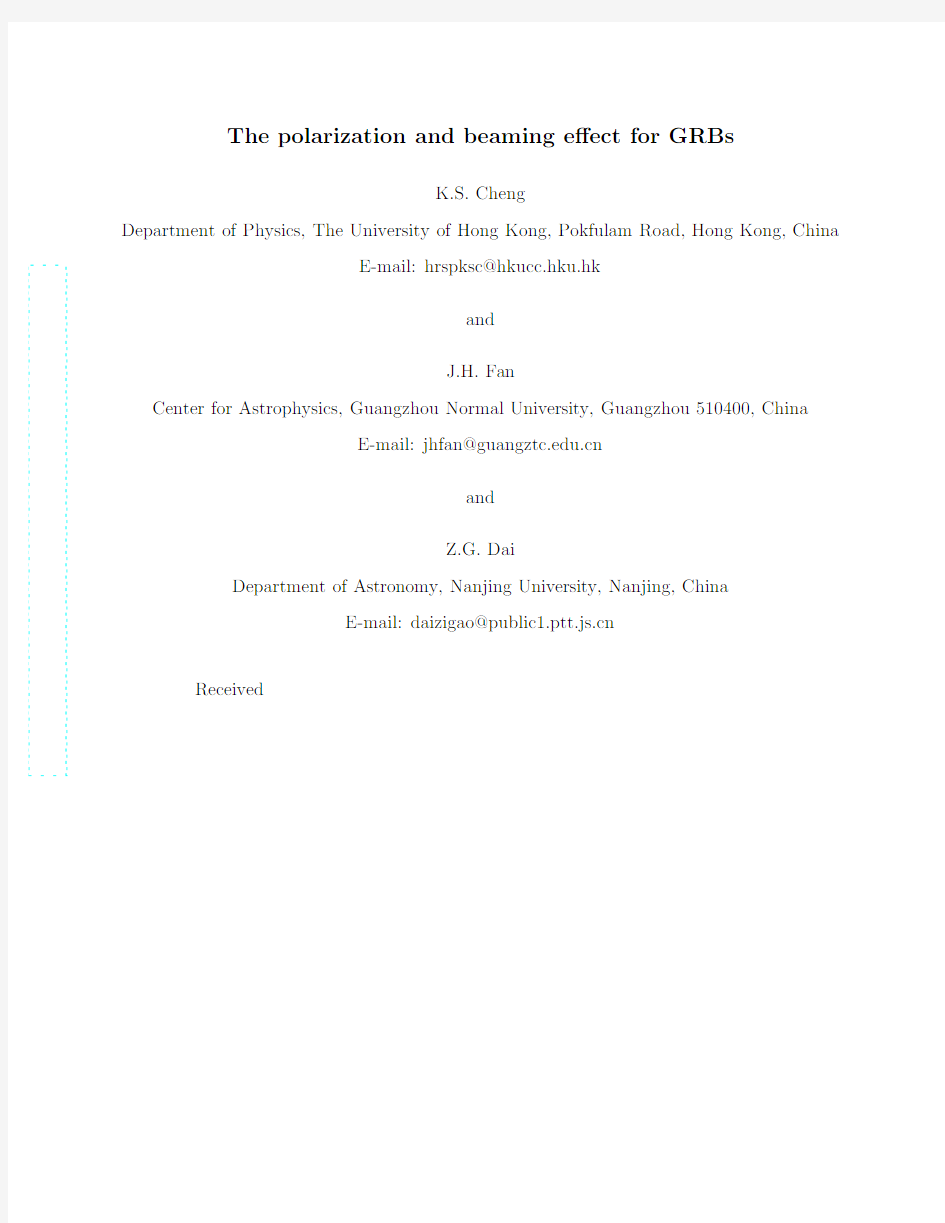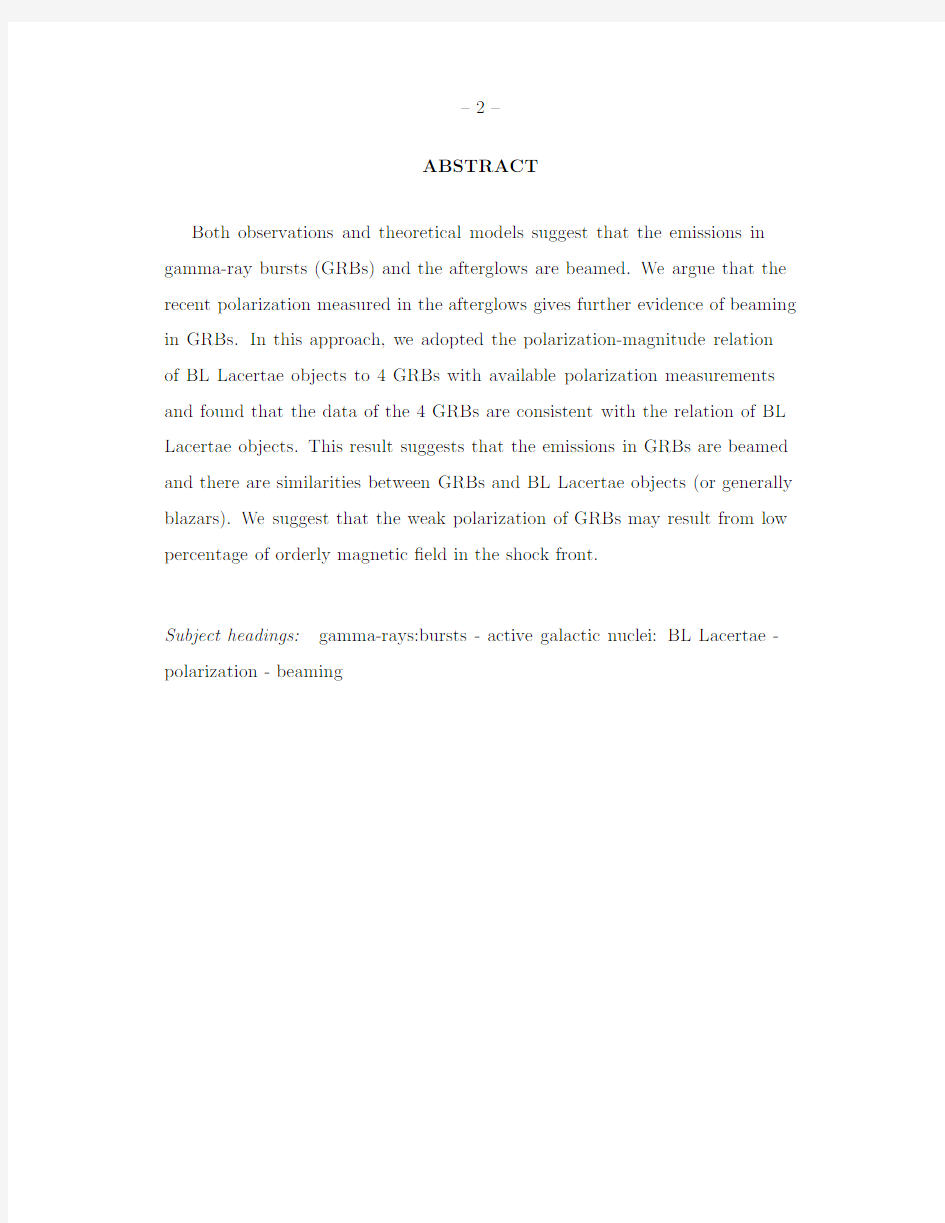The polarization and beaming effect for GRBs


a r X i v :a s t r o -p h /9910540v 2 19 N o v 1999The polarization and beaming e?ect for GRBs
K.S.Cheng
Department of Physics,The University of Hong Kong,Pokfulam Road,Hong Kong,China E-mail:hrspksc@hkucc.hku.hk and J.H.Fan Center for Astrophysics,Guangzhou Normal University,Guangzhou 510400,China E-mail:jhfan@https://www.360docs.net/doc/5310037635.html, and Z.G.Dai Department of Astronomy,Nanjing University,Nanjing,China E-mail:daizigao@https://www.360docs.net/doc/5310037635.html, Received
ABSTRACT
Both observations and theoretical models suggest that the emissions in gamma-ray bursts(GRBs)and the afterglows are beamed.We argue that the recent polarization measured in the afterglows gives further evidence of beaming in GRBs.In this approach,we adopted the polarization-magnitude relation
of BL Lacertae objects to4GRBs with available polarization measurements and found that the data of the4GRBs are consistent with the relation of BL Lacertae objects.This result suggests that the emissions in GRBs are beamed and there are similarities between GRBs and BL Lacertae objects(or generally blazars).We suggest that the weak polarization of GRBs may result from low percentage of orderly magnetic?eld in the shock front.
Subject headings:gamma-rays:bursts-active galactic nuclei:BL Lacertae-polarization-beaming
1.Introduction
It has been widely argued that gamma-ray bursts(GRBs)and afterglows are beamed. There is much observational evidence that the emission regions of GRBs as well as afterglows must be moving relativistically(for a review see Piran1999).The emitted radiation is strongly beamed,and one can observe only a region with an opening angle ofγ?1(where γis the Lorentz factor of the emission regions)o?the line of sight.Emission outside this narrow cone cannot be seen.These considerations have lead to the analytical speculations and numerical studies on the existence of jets in GRBs(Mao&Yi1994)and afterglows (Rhoads1997,1999;Sari,Piran&Halpern1999;M′e sz′a ros&Rees1999;Panaitescu&
M′e sz′a ros1999;Wei&Lu1999;Moderski,Sikora&Bulik1999;Dermer,Chiang&Mitman 1999;Huang et al.1999).Furthermore,the similarity in some of the observed properties between GRBs and blazars led to the speculation that jets also appear in GRBs(Dermer& Chiang1998).In addition,jets appear in the context of many models for the GRB energy source(e.g.,Ru?ert et al.1997;Paczy′n ski1998;Vietri&Stella1998;MacFadyen,Woosley &Heger1999;Khokhlov et al.1999;Wheeler et al.1999;Cheng&Dai1999;Aloy et al. 1999).
Recently,observational evidence for beamed afterglows has been reported.First,the redshifts of GRB990123and GRB990510combined with their observed?uences imply their isotropic energy releases of~3.4×1054and3×1053ergs respectively(Kulkarni et al.1999a;Harrison et al.1999),which are much larger than the energy budgets of the stellar-mass source models.Such enormous energetic budget requires that GRB radiation must be highly collimated in some GRBs.Second,the observed marked breaks in the light curves of the optical afterglows from these GRBs have been interpreted as an observational signature for jets(Kulkarni et al.1999;Harrison et al.1999;Stanek et al.1999)because, as argued by Rhoads(1997,1999),Sari et al.(1999),and M′e sz′a ros&Rees(1999),the
lateral expansion and edge e?ects of a relativistic jet may result in an obvious steepening of the light curve of radiation from the jet,although the other explanation also exists(Dai &Lu1999a,1999b).Third,the observed radio?ares of these bursts have been believed to provide an independent and excellent indication of a jetlike geometry in GRBs(Kulkarni et al.1999b;Harrison et al.1999).As argued by Waxman,Kulkarni&Frail1998),the radio afterglow from a spherical?reball must rise to peak?ux on a timescale of a few weeks; but owing to the lateral expansion,the radio afterglow from the forward shock of a jet must fade down about few days after the burst(Sari&Piran1999).Therefore,the relative faintness of the observed late-time radio emission implies the existence of a jet.Finally, more importantly,the polarization observed from the afterglows gives further evidence for beamed emission in GRBs and afterglows(see Gruzinov1999;Sari1999;Hjorth et al. 1999).If GRBs are similar to BL Lacertae objects,then we believe that these two kinds of objects must have similar properties.In this paper,we will discuss the relation between the polarization and the optical magnitude for4GRBs,which are the only GRBs with available data.
2.Model
Here,we summarize the main result of our previous paper(Fan et al.1997,1999, Papers I&II).The observed?ux,S ob j,of a relativistic jet is related to its intrinsic?ux,S in j, by S ob j=δp S in j,whereδ,the Doppler factor of the jet,is de?ned byδ=[Γ(1?βcosθ)]?1,βis the velocity in units of the speed of the light,Γ=(1?β2)?1/2is the Lorentz factor,and θis the viewing angle.The value of p depends on the shape of the emitted spectrum and the detailed physics of the jet(Lind&Blandford1985),p=3+αis for a moving sphere and p=2+αis for the case of a continuous jet,whereαis the spectral index.We consider a two-component model,in which the totally observed?ux,S ob,is the sum of an unbeamed
part S unb and a jet?ux,S ob j.Assuming that the intrinsic?ux of the jet,S in j,is some?xed fraction f of the unbeamed?ux,S unb,i.e.,S in j=fS unb,we have S ob=(1+fδp)S unb.If the ?ux is not totally polarized in the jet,and it is not unreasonable to assume that the jet?ux consists of two parts,namely,the polarized and the unpolarized,with the two parts being proportion to each other,i.e.,S in j=S jp+S jup,S jp=ηS jup,whereηis a coe?cient which determines the polarization of the emission in the jet,then the observed optical polarization can be expressed as
P ob=
(1+f)δp o
1+f
η
P ob2=
δ3+α
1
δ2
)3+αcan be expressed as
ζ=S ob1?S unb
S ob2
if we assume that neither S in or S unb is changed and S ob1is greater than S ob2.In this sense,the ratioζcan be written in the form ofζ=(S ob1
P2
=100.4(λ?1)?m(5)
Based on a37-BL Lacertae-object sample,λis found to be1.30±0.07with a chance of probability of2.0×10?5(Fan,Cheng,Zhang1999,Paper II).In this sense,relation(4)can be expressed in the form
logP(%)=(0.12±0.02)m+c1(6) where c1is a constant.Since GRBs likely show beaming as in blazar,then similar relation should be expected to exist for GRBs.
3.Application to GRBs
Recently,polarization was measured from the afterglow of gamma ray bursts(GRBs): P opt=1.7±0.2%for GRB990510(Covino et al.1999;Wijers et al.1999);P opt≤2.3% for GRB990123(Hjorth et al.1999);P Radio≤19%for GRB980329(Taylor et al.1998); P Radio≤8%for GRB980703(Frail et al.1998).These measurements likely suggest that the gamma-ray bursts are beamed(Gruzinov1999;Hjorth et al.1999;Rhoads1999; Panaitescu&Meszaros1998;Sari1999;Sari et al.1999).
The optical afterglow has been observed from many GRBs and found to be variable (see Bloom et al.1998;Castrio-Tirado et al.1999a,b;Djorgorski et al.1997;Galama et al. 1999;Garcia et al.1998;Groot et al.1998;Halpern et al.1999;Kulkarni et al.1999;Sahu et al.1997;van Paradijs et al.1997and references therein).Since most optical data are made in R band,here we adopted the R magnitude,which is obtained quasi-simultaneously with the measurements of the polarization.The relevant data are listed in Table1,where Col.1gives that name of the GRB,Col.2and3the polarization measurements and the corresponding reference;Col.4and5the photometric data and the corresponding reference.
The relevant data are shown in Fig.1,in which the solid line represent
logP(%)=0.12m R?2.06.It is clear that the data of GRBs are consistent with
the result(the slope)obtained for BL Lacertae objects(Paper II).
4.Discussion
Relativistic?reball models can explain the main properties of the GRBs and their afterglows(Rees&Meszaros1992;Paczynski&Rhoads1993;Katz1994;Meszaros&Rees 1997;Vietri1997;Waxman1997;Sari et al.1998;Wijers&Galama1999).Polarization can be observed if the?reball is beamed(Loeb&Perna1998;Waxman&Gruzinov1999; Hjorth et al.1999).The polarization data of BL Lacertae objects indicates that the radio selected BL Lacertae objects(RBLs)have very high polarization P~20%?40% and X-ray selected BL Lacertae objects(XBLs)also have moderately high polarization, generally P≤10%.In our previous papers(Fan et al.1997,1999,Paper I&II),we found that the polarization of these BL Lacertae objects is associated with the Doppler factor and the?ux density,particularly,there is a correlation between the observed polarization and the optical magnitude.When we used the relation to the polarization of GRBs,they are consistent with the relation of BL Lacertae objects and this suggests that(1)GRBs and BL Lacertae objects share similar properties and(2)the observed polarization in the afterglow of GRBs indicate that the emission is beamed.Sari(1999)and Ghisellini&Lazzati(1999) found that,the polarization value,assuming a highly beamed geometry,almost linearly increases with time on a timescale of1day after GRB although two to three peaks appear in the whole evolution stage of the polarization.Our taken data are about on1day after GRB(GRB990123and GRB990510),so the statistical result presented here is consistent with their theoretical one near this time.It has been shown that high polarization up to several tens percents is expected for GRBs if they are highly beamed(Loeb&Perna1998; Medvedev&Loeb1999;Waxman&Gruzinov1999;Gruzinov1999).However,the observed
Fig.1.—Plot of Polarization vs Magnitude–m R for4GRBs
polarization of GRB990510is only1.6%.Apparently such low polarization value seems to indicate weak beaming factor.But there two factors to a?ect the polarization,namely beaming factor(boosting factor)and the orderly magnetic?eld in the shock front(intrinsic factor).Since the optical polarization from BL Lacertae objects is emitted from regions much closer to the central power house,typically1015cm,where the magnetic?eld is much orderly.On the other hand,the optical polarization of GRB afterglows is emitted from regions much farther away from the sources where magnetic?eld is produced by turbulence and hence should be more disoriented.In fact,it we assume that the minimum beaming factor of GRB990510is order of the unity and?m~m ob=19.1,thenδ~100,which is quite consistent with the?reball models.Since only one source,GRB990510shows de?nite polarization,the constant,c1=?2.06,in the relation logP=0.12m R?2.06is obtained based on the data of GRB990510.If more polarization measurements are available,we would expect that the statistical coe?cient of m R is the same,0.12±0.02but the constant c1may be di?erent.
Acknowledgements
We are grateful for the invaluable comments and suggestions from Dr.A.Mitra.This work is partially supported by the RGC grant of Hong Kong,the National Pan Deng Project of China and the National Natural Scienti?c Foundation of China.
Table1:Polarization and photometric data for4GRBs
GRB980329≤21?T98≥23T98 GRB980703≤8?F98≥22B98 GRB990123≤2.3H9920.0C99 GRB9905101.6±0.2Co99,W9919.1Co99
REFERENCES
Aloy M.A.et al.1999,astro-ph/9910466
Castro-Tirado A.J.et al.1999a,ApJ,511,L85
Castro-Tirado A.J.et al.1999b,Sci,283,2069
Cheng K.S.&Dai Z.G.1999,astro-ph/9908248
Covino X.et al.1999,A&AL,348,L1
Dai Z.G.&Lu T.1999a,ApJ,519,L155
Dai Z.G.&Lu T.1999b,astro-ph/9906109
Dar A.1998,ApJ,500,L93
Dermer C.D.&Chiang,J.1998,astro-ph/9810222
Dermer C.D.,Chiang,J.&Mitman K.E.1999,astro-ph/9910240 Djorgorski S.G.et al.1997,Nat.387,876
Fan J.H.,Cheng K.S.,Zhang L.,Liu C.H.1997,A&A,327,947(Paper I) Fan J.H.,Cheng K.S.,Zhang L.,1999,A&A,(submitted)(Paper II)
Frail D.A.,et al.,1998,
https://www.360docs.net/doc/5310037635.html,/gcn/gcn3/147.gcn3
Galama T.J.et al.1999,Nat.398,394
Garcia M.R.et al.1998,ApJ,500,L105
Ghisellini G.&Lazzati D.1999,MNRAS,309,L7
Groot P.J.et al.1998,ApJ,502,L123
Gruzinov,A.1999,ApJL,525,L29
Harrison F.A.et al.1999,astro?ph/9905306
Huang Y.F.,Gou L.J.,Dai Z.G.&Lu T.1999,astro-ph/9910
Hjorth J.,Bjornsson G.,Andersen M.I.et al.1999,Sci.283,2073
Israel G.L.et al.1999,A&A,348,L5
Katz J.I.,1994,ApJ,432,L107
Khokhlov A.M.et al.1999,ApJ,in press(astro-ph/9904419)
Kulkarni S.R.et al.1999a,Nat.398,389
Kulkarni S.R.et al.1999b,ApJ,522,L97
Lind K.R.&Blandford R.D.1985,ApJ,295,358
Loeb A.,&Perna R.1998,ApJ,495,597
MacFadyen A.,Woosley S.E.&Heger A.1999,astro-ph/9910034
Mao S.D.,&Yi I.1994,ApJ,424,L131
Medvedev M.,&Loeb,A.,1999,ApJ,submitted(astro-ph/9904363)
M′e sz′a ros P.&Rees M.R.1997,ApJ,476,232
M′e sz′a ros P.&Rees M.R.1999,MNRAS,306,39
Moderski R.,Sikora M.&Bulik T.1999,ApJ,in press(astro-ph/9904310) Paczy′n ski B.&Rhoads J.,1993,ApJ,418,L5
Paczy′n ski B.1999,ApJ,494,L45
Panaitescu A.&M′e sz′a ros P.1999,ApJ,526,in press(astro-ph/9806016) Piran T.1999,Phys.Rep.314,575
Rees M.J.&Meszaros P.,1992,MNRAS,258,L41
Rhoads,J.E.1997,ApJ,485,L57
Rhoads,J.E.1999,ApJ,in press(astro-ph/9903399)
Sari R.1999,ApJL,524,L43
Sari R.,Piran T.,1998,ApJL,517,L109
Sari R.,Piran T.,Narayan R.,1998,ApJL,497,L17
Sari R.,Piran T.,Halpern J.,1999,ApJL,519,L17
Sahu K.C.et al.1997,Nat,387,476
Stanek K.Z.et al.1999,ApJ,522,L39
Taylor G.B.et al.1998,ApJ502,L115
Vietri M.1997,ApJ,478,L9
Vietri M.&Stella L.1998,ApJ,507,L45
van Paradijs J.et al.1997,Nat.,387,476
Waxman E.,1997,ApJ,485,L5
Waxman,E.,&Gruzinov,A.,1999,ApJ,511,852
Waxman E.,Kulkarni S.R.&Frail D.A.1998,ApJ,497,288
Wei D.M.&Lu T.1999,astro-ph/9908273
Wheeler J.C.,Yi I.,H¨o?ich P.&Wang L.1999,astro-ph/9909293 Wijers R.A.M.J.et al.1999,ApJ,523,L33
Figure Caption
Fig.1:Plot of the polarization against the optical magnitude for GRBs with available data.
